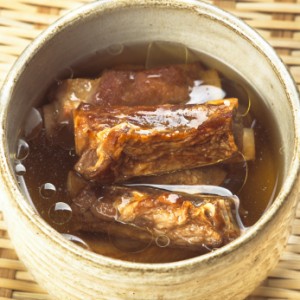 We are all familiar with the comforting bowl of homemade chicken soup when we feel under the weather. But do we realize the far-reaching benefits of the broth that is the base of this healing soup that has been around for ages?
We are all familiar with the comforting bowl of homemade chicken soup when we feel under the weather. But do we realize the far-reaching benefits of the broth that is the base of this healing soup that has been around for ages?
Bone broth has been used for centuries as people made as much as they could from the animals they used for meat. It’s long been known to have beneficial properties, but as food technology advanced, bone broth has largely been pushed to the side as people favor the convenience of canned or instant varieties of broth, stock, or bouillon. Unfortunately, when we opt for convenience, we end up with something with far fewer health benefits than the real deal.
What Can Bone Broth Do For Me?
Here are a few of the things that can be found in a typical bone broth and how they are beneficial to the body.
Cartilage
Cartilage, that connective tissue that is found in joints, the rib cage, and the vertebrae, to name a few places, is—wait for it—good for the joints. Cartilage contains chondroitin sulfate, which has been shown in studies to aid in controlling osteoarthritis joint pain. Shark cartilage has been shown in studies to help with joint diseases and in stimulation of immune cells. One might assume then that cartilage from other creatures might have the same effect. Cartilage is also said to improve gastrointestinal inflammatory conditions.
Rather than purchasing expensive supplements like chondroitin sulfate and shark cartilage from a pharmacy or health food store, I suggest you make your own! Choose bones with plenty of cartilage and you will have a much less expensive option in treating these disorders.
Gelatin
I remember my grandmother urging me to eat my Jell-O because it was good for my hair and nails. As a child, I never knew why. I also didn’t know where gelatin actually came from. Gelatin is basically the same thing as collagen, a protein that makes up 25 percent of the protein in the body. When the substance is in the body, we call it collagen; when it’s cooked in a bone broth, we call it gelatin. It’s the presence of this collagen/gelatin in the bones that causes the bone broth to turn into, well, a Jell-O-esque substance in the refrigerator.
Gelatin helps wounds to heal better, helps to prevent bruising, promotes digestion of proteins, and promotes formation of healthy skin and bones. It has a healing effect as it coats the mucus membranes of the gastrointestinal tract, which is why it is a huge part of the immune-system healing GAPSDiet, a way of eating that is becoming more and more popular as people look for ways of healing their bodies rather than simply treating symptoms.
Does bone broth sound worth it, so far?
Minerals
There are many trace minerals found in bone broth, including but not limited to:
Calcium – Calcium is a building block for strong bones and for tissue repair. It helps with muscle cramps, brittle nails, periodontal disease, depression, insomnia, and hyperactivity.
Phosphorus – We need phosphorus in our body in order to have energy. When our bodies do not have enough phosphorus, we tend to have problems like fatigue and weakness, tendency toward celiac, and even seizures.
Magnesium – Magnesium is a common deficiency, even in the U.S. Often, when a person has a hard time sleeping, frequent muscle cramps, or a woman has particularly bad PMS, a lack of magnesium may be part of the problem. Magnesium is needed for a whole host of bodily functions, being involved in over 300 enzyme reactions, and a cofactor of B1 and B6 vitamins. Proper thyroid function depends on a healthy dose of magnesium.
The Delicious, Money-Saving Way to Feed Your Family
These components of bone broth are just the tip of the iceberg, but for the purposes of this article, that will do. Find more information about bone broth at the Weston A. Price Foundation and in the book Nourishing Traditions by Sally Fallon.
How To Make Bone Broth
When preparing to make bone broth, the most obvious item you will need is bones. The most common types of bones to use to make bone broth are poultry, beef, fish, and lamb. Pork bones are generally not used to make bone broth, but they may be used when making a soup or stew.
Free ranging, organically raised animals are your best bet, as they will likely have more of the beneficial nutrients in their systems and fewer of the chemicals, antibiotics, and other substances you might not want to put into your body. If these are not available to you, or you cannot afford them, then commercially raised animals will do. They will offer many of the same benefits, and the end result of your bone broth will be far better than the commercial stock on the grocer’s shelf.
Let’s get started. Gather the following items:
- Bones, with or without meat (You may roast them to gain more flavor, but it is not necessary.)
- Any vegetables you care to add
- Large crockpot or stock pot
- Water to fill the pot
- Vinegar or lemon juice
- Strainer
- Large bowl
- Ladle
- Storage containers
1. Place your bones and vegetables (if desired) into the pot.
2. Fill pot with water.
3. Add a splash or two of vinegar or lemon juice. Stir to combine. This step helps to soften the bones and make the nutrients more available as the stock cooks.
4. Bring to a boil, then turn down and simmer for twenty-four hours.
5. Check on it from time to time. Skim the top with a spoon if it looks foamy and discard what you skim off.
6. After twenty-four hours, your bone broth should be finished. Remove from heat and allow to cool.
7. Once cool enough to handle, place strainer into bowl and begin pouring/ladling broth through strainer into bowl. You may need to use two bowls, depending on how much broth you made and the size of your bowl.
8. Once your bone broth has been strained, place the bowls of broth in the refrigerator to cool completely.
9. There will be a layer of fat on the top of the broth once it is cooled. If desired, you may remove this at this time.
10. Ladle bone broth into storage containers and freeze. (I re-use thirty-two-ounce yogurt containers. Ice cube trays also work well for times when you need less bone broth at a time.) Bone broth keeps for a long time in the freezer.
Alternative: There are some that swear by and enjoy bone broth that has the bones and other ingredients blended into it. This makes a much “creamier” looking broth. If you want to try this, make sure your bones are sufficiently softened, and simply pour the bones/veggies into your blender (not too many at a time!) with some of the liquid and blend.
Bone broth may be cooked longer than twenty-four hours. Additionally, depending on how long you simmer your first batch, you may be able to get a second batch of bone broth from your bones once you have strained your first batch. It will likely not be as strong as your first batch, but will still have beneficial properties.
How Do I Use Bone Broth?
Use bone broth as you would any commercial broth, stock, or bouillon, such as in soups and stews. Bone broth can be used in place of water when cooking rice, as a base for making sauces, or simply consumed on its own as a beverage or snack.
How do you like your bone broth?
 Off The Grid News Better Ideas For Off The Grid Living
Off The Grid News Better Ideas For Off The Grid Living




